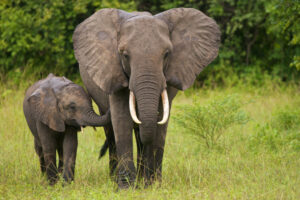My favorite ice-breaker of all time is: “List one fact about you that no one would guess”. It is my favorite because I have an awesome answer (if I do say so myself). My go-to answer is: I spent a summer working with elephants.
It was the summer before I graduated from college, and it was really only one elephant, a five-year-old African elephant named Connie. Connie was intelligent, curious and mischievous—her favorite game with me was trying to untie my shoelaces (hint: double knotting is important). Working with her was one of the most amazing experiences of my life and left me with an abiding love for these creatures.

Understandably, I was excited last year when one of my fellow bloggers wrote about Promega helping support the work of Virginia Riddle Pearson, who was working to identify and track strains of elephant endotheliotropic herpesvirus (EEHV) in African Elephant populations. EEHV is associated with the lethal elephant hemorrhagic disease (EHD) (1). This disease is a serious threat to the captive breeding programs of these endangered creatures. Between 1962 and 2007, it accounted for 58% of the deaths of North American captive-born Asian elephants between 4 months and 15 years of age (1). These deaths include the first Asian elephant calves born at the National, Oakland and Bronx Zoos. EHD also claimed the first live-born Asian elephant calves conceived by artificial insemination in both North America and Europe.
Elephants have a life cycle similar to humans. Females don’t reach reproductive age until 12–15 years of age. Their gestation cycle is close to 22 months (yes, they are pregnant for almost two years) with around five-year intervals between calves. This long reproductive cycle is what makes EHD such a threat to the relatively small captive breeding populations of both Asian and African elephants.
EEHV belongs to the novel Proboscivirus genus, and appears to have evolved separately from all other mammalian herpesviruses over the last 100 million years (2–4). Acute EEHV disease (EHD) has a fatality rate of 80% and affects primarily Asian elephant calves between the ages of 1 and 8 years (1). There are six types of EEHV that have been largely characterized, with a seventh now identified.
Although cross-species infection was first suggested as the cause of lethal EHD infections in Asian elephants, we now know that EEHV infection is largely species-specific. EEHV1A, EEHV1B, EEHV4 and EEHV5 are found in Asian Elephants, with strains of EEHV1 being associated with most lethal infections. African elephants harbor EEHV2, EEHV3, EEHV6 and the newly identified EEHV7. In fact, there has been only one known case of fatal cross-species infection, where an Asian elephant was infected with an EEHV type, EEHV3, from an African elephant (1).
To date, EEHV has not been successfully propagated in cell culture, which limits our understanding of the virus’s pathogenesis and epidemiology. However, thanks to advances in genetic sequencing techniques, we do have fairly complete sequence data on at least six EEHV types. As a result, researchers have developed diagnostic PCR assays that allow them to identify the presence of EEHV infections in elephant populations using non-invasive methods (e.g., trunk washes and saliva sampling; 5). The results of these studies seem to show that infection with one or more type of EEHV is ubiquitous in most populations, suggesting that it is something more than just viral infection that causes EHD.
Even though scientist have not yet determined what might cause an EEHV infection to be lethal, the ability to quickly test for the virus in an individual that displays symptoms, means they can respond more quickly with treatment. They can also monitor the progression of disease as well as the health of the rest of the herd (6).
The future of these endangered creatures is uncertain. What gives me hope is that there are dedicated scientist like Ms. Pearson who look to understand and defeat the tiniest threat to our largest land mammal.
References
- Zong, J-C. et al. (2016) J. of Virol. 90, 3028–43.
- Ehlers. B. et al. (2006) J. Gen. Virol. 87, 2781–9.
- Richman, L.K. et al. (2014) J. Virol. 88, 13523–46.
- Zong, J-C. et al. (2014) J. Virol. 88, 13547–69.
- Acckermann, M. et al. (2017) Identification of shedders of elephant endotheliotropic herpesviruses among Asian elephants (Elephas maximus) in Switzerland. PLOS ONE May 3, 2017 accessed November 17, 2017.
- Bronson, E. et al. (2017) J. Zoo and Wildlife Med. 48, 335–43.
Kelly Grooms
Latest posts by Kelly Grooms (see all)
- The Battle of Shiloh’s Angel’s Glow: Fact, Civil War Legend or Modern Myth? - July 11, 2024
- Mind Control, Mutilation and Death. The Fungal Fate That Lurks in Waiting for Emerging Periodical Cicadas - June 13, 2024
- Measles and Immunosuppression—When Getting Well Means You Can Still Get Sick - May 13, 2024
